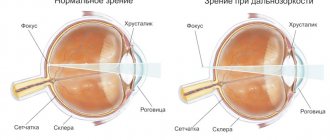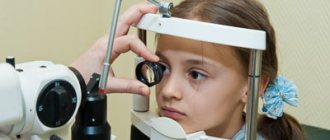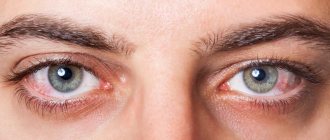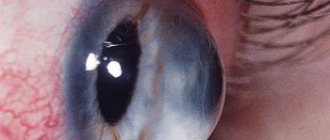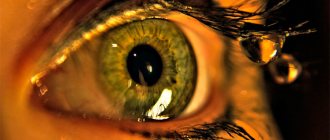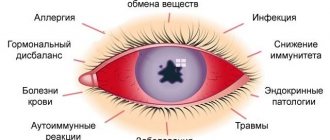Hypermetropia is a visual impairment in which a person sees well in the distance but poorly near. It is also called “weak refraction”, since the image is focused in the imaginary space behind the eyeball.
To correct vision, glasses or contact lenses with a plus sign are used. They are often also called “senile”, although hypermetropia also occurs in children, adolescents, and adults. At a young age, a small degree of this disorder is compensated by the reserves of the body, the eye itself. And often people with hypermetropia do not use glasses. However, over the years, often after 30, complaints arise about poor vision when reading and visual work at close range. Then distance vision begins to suffer.
Farsightedness in children
In all cases, hypermetropia is a congenital condition. A child at birth normally has hypermetropia, since his eyeball is still small. With age, the eye enlarges and focusing becomes normal. In some children, the eyeball “loses” its growth rate, and then farsightedness occurs as a persistent deviation from normal development. At school age, this deviation can be compensated by excessive stress of accommodation, and the patient can ignore glasses. However, the presence of strabismus or amblyopia may again require the use of glasses.
Causes of hypermetropia
Most often, the development of hypermetropia is caused by the irregular shape of the eyeball, which is reduced in its longitudinal size. All children are born farsighted. As babies grow and, accordingly, their eyeballs, vision function gradually returns to normal. By the age of four, children usually have good vision both far and near.
Hypermetropia is often observed in older people. This is due to the fact that with age, the lens of the eye loses its ability to change curvature, i.e. to accommodation.
This process begins at the age of 25, but leads to a deterioration in visual function only after a person reaches the age of 45–50 years. By the age of 60, the ability of the lens to accommodate is completely lost. In this case, they talk about senile farsightedness or presbyopia.
Symptoms of farsightedness
Contrary to the name “farsightedness,” good distance vision occurs only with a weak degree of hyperopia and in relatively young subjects: in other cases, vision is poor both near and far. There is also the concept of “hidden hypermetropia”. It is discovered by chance, during a routine examination when special drops are instilled that dilate the pupil.
In clinical manifestations, hypermetropia is characterized by often occurring strabismus, which is detected at an early age in a child and does not go unnoticed. But the most important problem is amblyopia or “lazy eye”, that is, low visual acuity that does not reach normal levels even with glasses!
The appearance of any symptom requires immediate contact with a qualified specialist who will conduct a competent diagnosis and prescribe treatment.
Symptoms and diagnosis of hypermetropia
With mild hypermetropia, people experience difficulty only when looking at nearby objects. Distance vision is usually preserved. Therefore, they only need glasses to work.
As the disease progresses, distance vision also begins to suffer. In this case, doctors prescribe glasses to their patients with farsightedness not only for work, but also for constant wear.
If hypermetropia is not corrected, frequent and persistent headaches occur, often associated with high visual loads. Many patients complain of increased eye fatigue when reading.
When working and reading, people with hypermetropia try to strain their vision. This leads to a feeling of discomfort and burning in the eyes. A person involuntarily begins to rub his eyes with his hands, thereby introducing various infections into them. As a result, he often develops various inflammatory diseases: barley, chalazion, blepharitis, conjunctivitis.
With hyperopia, patients tend to move their book further away while reading, thereby improving the visible image of the letters. However, in some cases, farsightedness does not manifest itself in any way and is diagnosed only by an ophthalmologist during an examination and determination of visual acuity.
Treatment of farsightedness
Confirmation of the diagnosis of hypermetropia requires timely correction of this visual impairment.
- There is no drug therapy.
- Correction with contact lenses and glasses. The choice between contact lenses and glasses is up to the patient and depends on his personal preferences. The strength of the lenses is selected strictly individually. In some cases, it is possible to use nighttime orthokeratology lenses for a reversible correction effect during the day.
- Laser correction. A modern procedure that effectively restores vision by changing the shape of the cornea. Compared to a similar method for myopia, high efficiency applies only to hypermetropia up to +4.0 diopters. In all cases, before recommending surgery, it is necessary to conduct a specialized examination.
- In cases where laser correction is not indicated or is ineffective in the prognosis, surgical intervention inside the eye is recommended - implantation of an intraocular lens while preserving its own lens (phakic lens implantation) or implantation of a lens to replace the removed lens of the eye (phacoemulsification with implantation). The latter operation is performed when phakic implantation is contraindicated and/or in “aged” patients.
Prevention of hypermetropia
Prevention of the development of farsightedness consists of taking measures to create the most comfortable working conditions, as well as proper and balanced nutrition.
It is advisable to stay in front of a computer monitor for no more than two hours during the day, and at the same time it should be located at a distance of more than 40.0 cm from the eyes. You should also watch TV less than two hours a day, and you need to be more than two meters away from it. Currently, these restrictions can be somewhat expanded when using LCD/LED TVs and monitors.
During the working day, it is necessary to perform small eye exercises every two hours, which consists of shifting your gaze from nearby objects to distant ones. It is advisable that a nearby object be at a distance of 50.0 cm from you, and a far away object should be over 5.0 meters.
In addition, you should not stay in rooms with insufficient lighting for a long time or read while lying down. Timely detection of eye diseases and intracranial hypertension is also important for health.
Team of doctors Ochkov.Net
Let's sum it up
Plus glasses today remain the most common method of vision correction for hypermetropia at any age.
Contact lenses allow you to increase the degree of freedom of a patient with clinical manifestations of hypermetropia.
The best way to relieve a patient of poor vision is only through refractive surgery and intraocular (intraocular) implantation. Operations are performed in adults, sometimes in adolescence.
If there are contraindications to laser correction, an alternative to surgery is night (orthokeratology) lenses, which reversibly eliminate hypermetropia.
It is recommended to monitor vision from an early age in order to identify hypermetropia and astigmatism; it is necessary to take measures in the form of glasses or contact lenses as early as possible.
Diagnostic measures
Get a complete vision examination at the Lege Artis Eye Clinic
It's time to correct your vision!
Make an appointment by phone:
8(804) 333-02-14 Free call
Diagnosis of hypermetropia in children is carried out by an ophthalmologist. Visual acuity testing is carried out using different methods, depending on the age of the child. Also, before the study begins, drops are instilled into the eye to dilate the pupil. This leads to relaxation of the ciliary muscle and allows you to correctly measure the light refractive ability of the eye. For timely detection of farsightedness, it is recommended to visit a pediatric ophthalmologist at least once a year.
Diagnosis consists of collecting an anamnesis, parents provide complete information about the child’s behavior and present complaints: a child with problems with visual perception quickly gets tired, becomes withdrawn, has a predominant bad mood, school-age children are characterized by slow reading, but bright pictures at a distance (billboards, posters) they look at with great interest.
To identify farsightedness, different diagnostic methods are used:
- visometry - tables with pictures are used for children, tables with letters are used for middle school children;
- determination of violations of the refractive power of the eye is carried out using autorefractometry, necessarily in conditions of cycloplegia: drug dilation of the pupil and switching off accommodation;
- skiascopy and retinoscopy.
How does farsightedness begin?
Only a specialist can make a correct diagnosis and determine the extent of the disease, but the first symptoms can be detected independently, including emerging farsightedness in children.
The most pronounced symptoms of farsightedness are:
- poor vision at close range;
- poor distance vision (with fairly large degrees of hypermetropia);
- increased eye fatigue when working or reading;
- eye strain during work (burning eyes, headaches);
- amblyopia (“lazy” eyes) and strabismus – farsightedness in children;
- frequently occurring inflammatory processes in the eye area (blepharitis, conjunctivitis, chalazion, stye).
According to the degree of the disease they are divided:
- Weak degree up to (+2 diopters). It occurs in the early stages of the disease and is characterized by increased fatigue, seemingly causeless headaches and even dizziness. Diagnosing the disease, especially farsightedness in children, can be very difficult, since changes in the quality of vision are almost invisible. At this stage, farsightedness correction gives good results.
- Medium degree (from +2 to +5 diopters). Merging letters when reading, unclear visibility of small objects near, their unclear contours, but the absence of complaints about distance vision are signs of moderate farsightedness. Recommended correction of farsightedness or prescribed treatment for farsightedness is carried out only after a thorough examination.
- High degree (over +5 diopters). Poor vision, both near and far, and low ability to focus. To improve the patient's condition, treatment of farsightedness is required.
What can cause farsightedness?
Farsightedness in children is a reduced size of the eyeball along the anterior-posterior axis. This is why almost all babies are farsighted. Developing along with the entire body as a whole, the eye “stretches” and vision returns to normal.
It is a mistaken belief that a person with farsightedness only has problems seeing objects at close range, but they see things that are far away well. But visual impairment affects the quality of any vision - both near and at a distance. However, people suffering only from age-related farsightedness see well into the distance because the lens is constantly in a state of relaxation and has no refractive errors. Farsighted people often experience severe headaches when doing close work.
What is called “age-related farsightedness”?
Age-related changes that lead to farsightedness can begin around age 25. However, it is not until we reach the age of 40-50 that we begin to have difficulty reading at the usual (25-30 cm from the eyes) distance. By the age of approximately 65 years, the eye may almost completely lose its ability to accommodate.
How to treat presbyopia and farsightedness?
Modern ophthalmology offers not only conservative, but also surgical (advanced) methods: correction of presbyopia and correction of farsightedness. The form of correction is selected depending on the results of a medical examination (including farsightedness in children), wishes, lifestyle and type of activity of the patient. At the end of the examination, the doctor who conducted it will ask you to choose an acceptable method for returning good vision. In addition to the well-known methods, such as wearing glasses or contact lenses, surgical correction of farsightedness has also proven itself today:
- laser vision correction using various techniques (LASIK, Femto-LASIK, SMILE);
- replacement of a transparent lens for refractive purposes;
- implantation of a positive phakic anterior chamber lens (PCL).
Any ophthalmological operation to correct hypermetropia currently performed is painless. It lasts for 10 to 15 minutes. There are no stitches or incisions during the operation and long-term rehabilitation after its completion is not required. The next day, practically, you will lead a normal, measured life, again enjoying good vision. Other visual impairments (cataracts or astigmatism) can also be corrected in this one operation.
